About the ATN
The Alaska Tribal Network (ATN) – A Tribally governed solution for solving the middle and last mile challenges to provide “Broadband For All” in Alaska now and forever.
The Alaska Tribal Network (ATN) refers to a standards-based last mile LTE network design that uses Tribal 2.5 GHz spectrum to distribute broadband data and cellular service throughout your community.
The ATS mission is to deliver quality broadband and cell phone services now to all of rural Alaska. For a complete understanding about the ATN, we present ATN specifics below as step 2 in the context of the overall three steps needed to deliver broadband for all anywhere in the state now. Building the ATN in every community is the centerpiece and focus of the ATS mission and the design for requested grant funding.
We also use the term ATN to refer to the larger network of all of the local ATN communities. As part of an overall statewide ATN system, when fully implemented, any equipment or plans purchased for use in your ATN last mile will work seamlessly when you are anywhere in the state, in any other ATN community. Also, via interconnect arrangements with major phone carrier networks, you will be able to roam in all major Alaska metro areas and the rest of the US.
Three Steps to Delivering “Broadband For All” Everywhere in Alaska Now
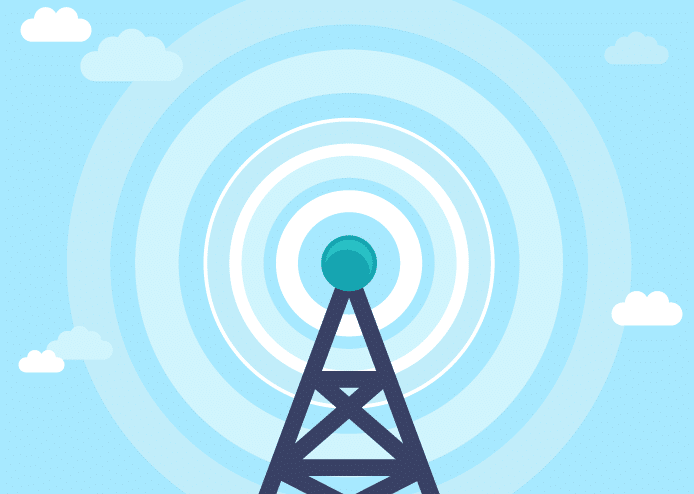
Step 1—Acquire Statewide 2.5 GHz Last Mile Radio Frequencies from FCC (DONE)
98% of Alaska is covered by all licensees – ATS manages licenses for over 100 Tribes working together.
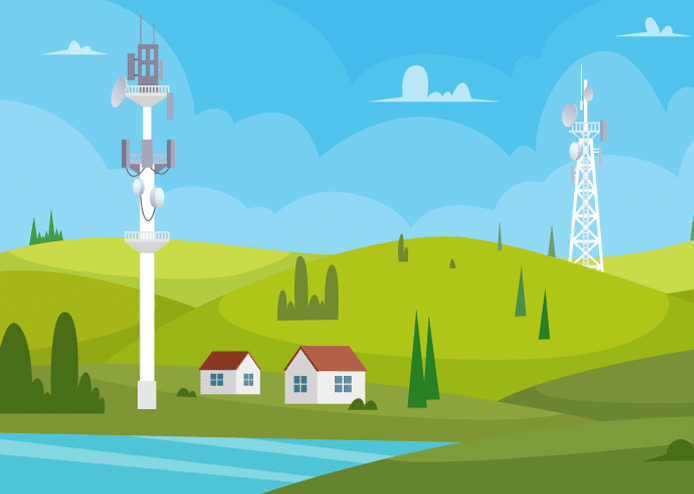
Step 2—Build the Last Mile Alaska Tribal Network (ATN) in Each Community
The Tribal 2.5 GHZ wireless spectrum makes possible a LTE 4G/5G capable last mile in every rural community.

Step 3—Connect Each Last Mile ATN Community to an Affordable Middle Mile
In areas without access to fiber, use satellite (available NOW.) Connect the ATN to fiber if/when available.
Step One—Acquire Statewide 2.5 GHz Last Mile Radio Frequencies from FCC
This is COMPLETE—Can be used to enable a wireless last mile to rural communities throughout Alaska
In August of 2020, the ATS Tribal nonprofit was formed with a mission to ensure the maximum number of Tribes in Alaska could reserve 2.5 GHz spectrum which was being offered for free from the FCC. ATS applied for spectrum representing 85 tribal member areas, and in March of 2022, ATS was awarded the largest single 2.5 GHz license in the US. Since then, many additional tribes have joined ATS as managed members. With over 100 members and growing, this combined spectrum area (shown below) can be used to create advanced tribally owned networks. (See Step 2)
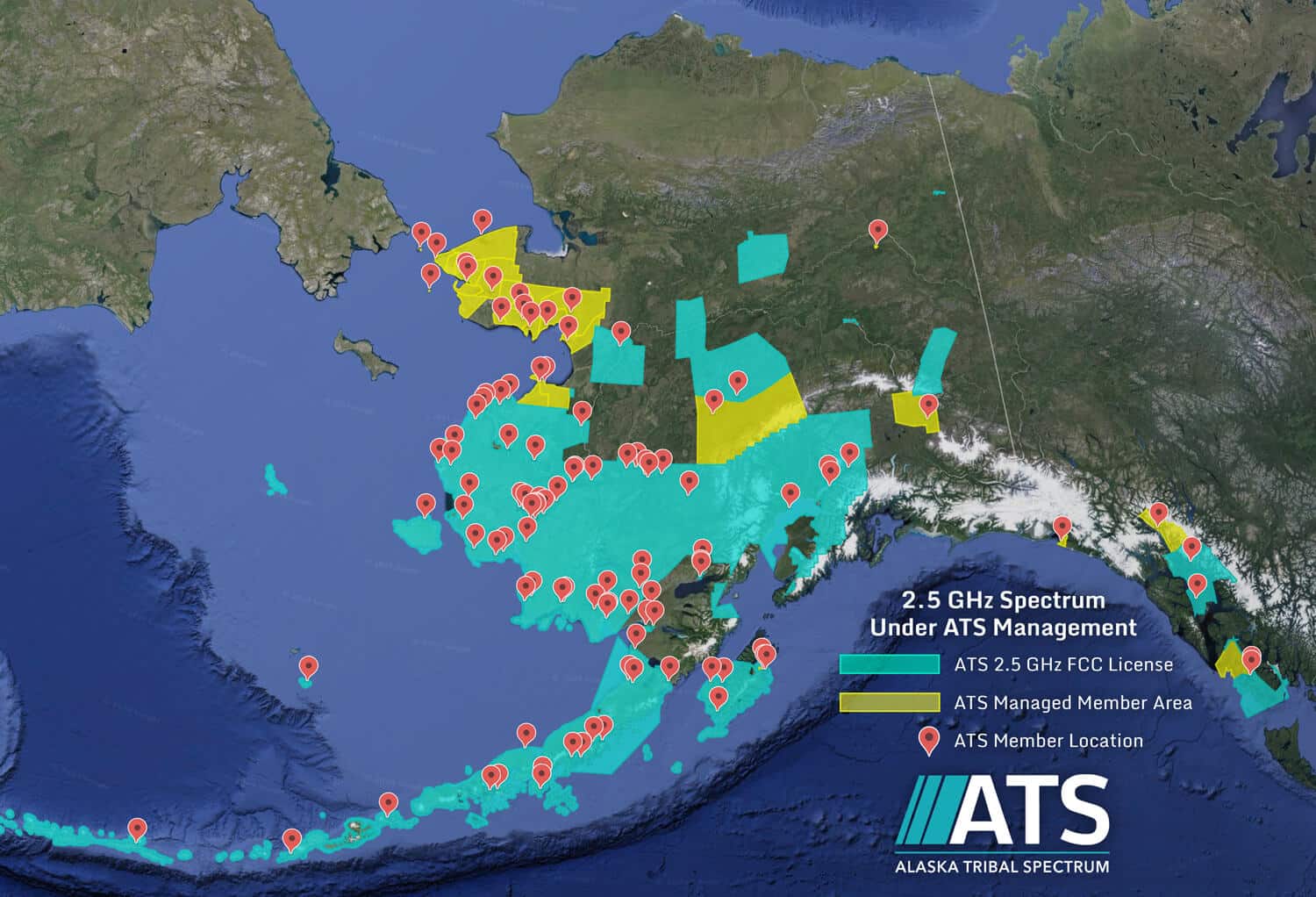
Step Two—Build the Last Mile Alaska Tribal Network (ATN) in Each Community
The Tribal 2.5 GHZ wireless spectrum makes possible a LTE 4G/5G capable last mile in every rural community
This Tribal 2.5 GHz wireless network is capable of connecting to any middle mile that is available now, or whatever middle mile becomes available in the future. The ATN can deliver broadband and cell phone service community-wide. Government grants or private funds can be used to build this last mile.
Per its mission, ATS applies to the NTIA and other government agencies as a large multi-member Tribal organization for funding to create a modern 4G/5G capable LTE last mile network in each member community. This ATS last mile design is referred to as the Alaska Tribal Network, or ATN.
There are many benefits to implementing an ATN wireless model for Virtual Service providers to bring service to your community, including:
- It uses Tribal wireless 2.5 GHz spectrum, and satisfies FCC buildout requirements to retain it
- It is able to provide broadband AND cell phone service over the spectrum for true mobility and e911
- It will connect to any middle mile that is available including satellite and/or fiber when ready
- It leverages a drop-ship container design—no required permitting, no digging, and rapid deployment
- It is gig-speed capable, 4G/5G capable LTE service village-wide
- Network management and support is provided for each tribe. Governance is through the ATS Policy Board.
- It generates Tribal revenue when the spectrum is used
- It is a statewide solution—Any internet service provider or telecom provider can use your ATN network to deliver high quality service to your community

Upon funding, each village is shipped a container with everything needed to assemble and sustain the ATN. There is no extensive digging required and the service can be set up within a week after delivery by an official ATN certified installation team. There is no equipment to install on any building to receive service. The installation process is coordinated closely with each Tribe and the ATS outreach teams to ensure maximum awareness and benefit for the community. Service providers will control signup for broadband or cell phone service that is simple and quick. Tech support is provided in abundance if needed.
To make the vision of affordable broadband a reality for rural Alaska, we need to connect these Step 2 last mile networks to an affordable middle mile. That brings us to step three.
Step Three—Connect Each Last Mile ATN Community to an Affordable Middle Mile
In areas without access to fiber, a satellite middle mile is available NOW. The ATN will also connect to fiber, should it become available
Possible middle mile choices that can deliver connections to the internet at broadband speeds are fiber, microwave back to fiber, and satellite. Depending on where you live, you may have access to one, more than one, or neither—and prices for those connections may be expensive or affordable.
Middle Mile Scenario 1
For those living in an area where there is NO fiber now, and none coming for many years
For a large part of rural Alaska, fiber isn’t coming anytime soon. In the meantime, the last mile wireless ATN will connect to available satellites over Alaska to deliver broadband and cell phone service immediately . These satellites include Low Earth Orbit (LEO) (Starlink and OneWeb) right now, and high-speed Geosynchronous Earth Orbit (GEO) soon. Satellite backhaul is purchased by virtual service providers who use it to create consumer or business packages that are offered in your community. Using satellite backhaul, 25/3 speeds are the minimum. 100/20 speeds and greater are also available. This is next generation satellite technology. It is far more reliable and capable compared to the old existing satellite service you may have had to endure. By 2024 to 2025, there will be additional LEO, Mid Earth Orbit (MEO), and GEO arriving for Alaska. Prices will continue to drop as service capacity increases.
ATS enthusiastically supports communities in their efforts to bring fiber to their villages. In the meantime, the ATN will allow Internet Service Providers to create service packages for the residents using satellite as the only available middle mile.
Middle Mile Scenario 2
For those living in an area where there is fiber nearby, or coming in a few years
If fiber is in your community now, the wireless ATN will simply connect to it to enable Service Providers to use your Tribal wireless last mile to provide added services like cell phone and e911. If the fiber will arrive in a few years, your wireless ATN will connect to a satellite middle mile now to provide reliable service community wide while you wait for fiber.
Connecting the fiber to your ATN allows you to have service everywhere in your village including your home. A fiber to the home connection does not give you the ability to leave your home and take the broadband or cell phone service with you. It also locks you into one provider and limits any competition or tribal choice.
ATS believes the future is all about mobility. Service should follow you wherever you go. A wireless network gives you that mobility. A fiber to the home only solution does not. Having fiber to the home AND a wireless network gives you the highest end solution. You have massive capacity at home and the wireless gives you mobility.

Benefits of the ATN design for your community
Benefits include Tribal revenue, better equipment pricing, and more for your community.

Benefits of being a member of ATS
Benefits include Tribal revenue, ATN design advantages, chances for additional revenue, and more.
ATN Conceptual Model—Learn more below
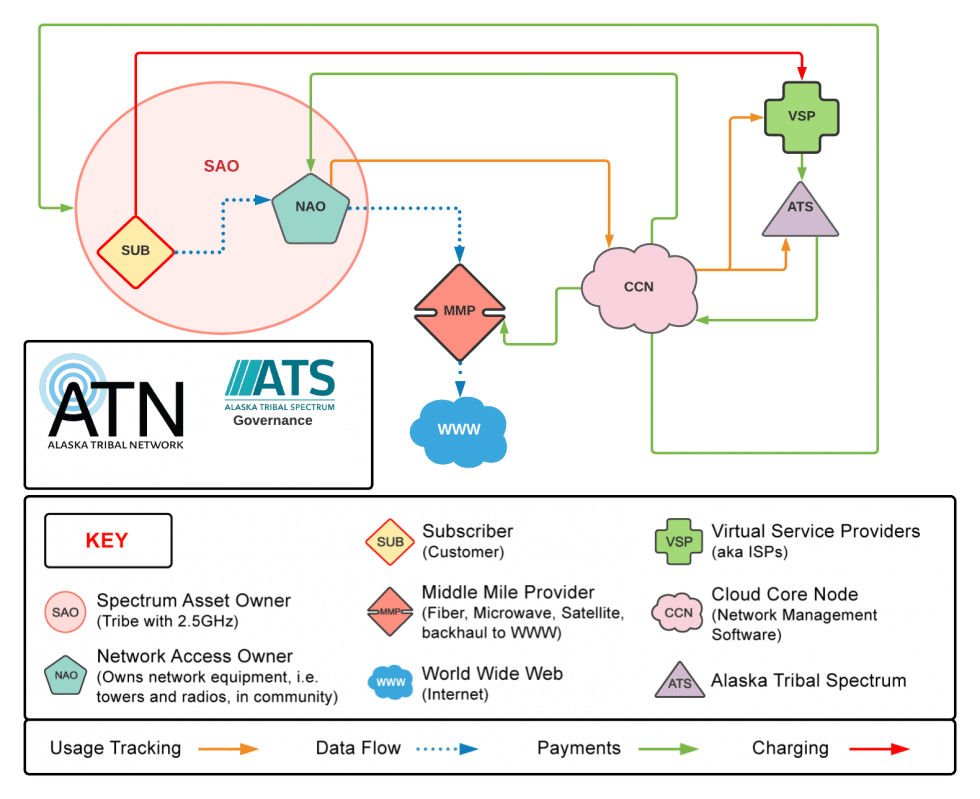
Alaska Tribal Network Participants and Roles
The ATN offers an inclusive win-win model for everyone.
The diagram above describes the basic roles and flow of data, and revenue for the ATN in a community. This is a subset of a much more detailed concept paper. Read on for more information about each role.
Spectrum Asset Owners (SAO)
These are the ATS managed member Tribes who own the spectrum and let ATS manage it for their benefit. It also represents the role for ATS charter and associate members that receive revenue for spectrum use in their Tribal areas.
In order to be on the ATN, a Tribe must be an associate or charter member or have a spectrum management agreement with ATS or be a managed member of ATS. All data that runs over this spectrum generates income by default for the individual ATS member Tribes. Data can also roam over the network from other large providers and the SAOs will generate income.
Spectrum owners will earn micro payments in proportion to the amount of data flowing in their spectrum holding area. A Tracking Area Code (TAC) is used as a differentiating mark. A spectrum owner may have more than 1 TAC associated with their ownership.
Each shape file submitted during the tribal priority filing window, will be equal to a Spectrum Asset Owner Account (SAO) on the Alaska Tribal Network (ATN). Contained in each of those SAOs will be sub groups that are defined as Tracking Area Codes (TACs). TACs are used to both determine rate of recovery and generate data detail records (DDRs) for SAOs to be paid.
Network Access Owner (NAO)
NAOs own the network equipment in each community. ATS will ensure the network is managed properly. Each Tribe has the option to choose to have no management or operational responsibility for the ATN, or they can be NAOs if they can meet NAO requirements. They can just choose to receive quality cell phone and broadband data service from the VSPs who use the ATN to deliver service. ATS will ensure the network is maintained and managed, however, some Tribes may wish to participate as NAOs and own the network equipment in their community if they have the capability to manage and maintain the equipment per ATN requirements. An NAO on the ATN will earn income on the data from all VSPs who are using the network over that equipment.
This model creates incentive to keep network elements online. NAOs use equipment that conforms to a set of standards determined by the network policy adopted at the ATS. A network access device (NAD) is preconfigured to automatically connect to the ATN.
Virtual Service Provider (VSP)
Community members pick their Service Providers from a list of ATN-certified providers (ATS is not an ISP, nor will it be, but ATS will maintain the standards of service for all VSPs that serve the network.) that are capable and approved to offer service in your community. We refer to them as Virtual Service Providers (VSPs) because they are riding on the ATN and offer broadband packages that are delivered over the network to subscribers.
Virtual Service Providers can be existing providers in the community or new providers. VSPs will have the primary customer relationships and sell packages for internet or phone service of their design, and bill their subscribers (SUB) that receive their service. VSPs purchase wholesale access from ATS based on a transparent set of areas they select. They supply level one support for their customers. Everything else on the ATN can be provided for them. Usage is tracked and provided to them via the Cloud Core Node. VSPs and certain services may require integration with the network to which APIs will be made available for providers to integrate.
An ATS member Tribe can choose to be a VSP if they desire and have the capability to meet ATN requirements and high-quality standards to be a VSP. Tribes make all choices to participate at whatever level they decide. They have the right to be a provider of service, an owner of network equipment, both, or neither.
Cloud Core Node (CCN)
Cloud Core Nodes run applications for network functions and create cloud infrastructure for VSPs to leverage through APIs. CCNs are compensated based on the traffic that passes on the node, similar to how the NAOs are compensated. A rate of recovery is determined using quantifiable metrics taken from the performance of the CCNs. Example metrics may be location in the network, response time for applications, external services offered, power costs directly associated with the operation of the CCN, system load, uptime, etc.
The rate of recovery for operation of the CCNs will be governed by ATS and paid to the Network Operations Provider. The CCN will be owned by the ATS who will collect the recovery rate. CCNs will be managed by the Network Operations Provider to provide monitoring, management, maintenance (MMM) and authorization, access and accounting (AAA). The CCN controls the network and requires transparency of its functions and operation. Additionally, In order to ensure the best possible level of service and to develop against the system, a single entity will be responsible for its function.
Alaska Tribal Spectrum (ATS)
ATS, as a multi-member organization of many Tribes across the State, will provide funding for the ATN through grants that will be used to provide last mile wireless networks in its member communities. These networks will be compatible with ATN standards and be certified as compatible with the overall ATN roadmap to not preclude future mobility capabilities. ATS will also work to acquire funding for advanced LEO and/or GEO satellite middle mile capacity that will be used by providers in its member communities. This combination will bring affordable broadband that will be used over the member Tribe’s 2.5 GHz spectrum and produce revenue as well.
Initially grant funding will secure and launch and build out of the ATN. After the initial funding mechanism is used to build the network ATS will collect access charges from VSPs paying for backhaul and access to the network to deliver services. ATS bills VSPs for the usage that their customers have on the network and for basic access fees. ATS will distribute the funding to all other ATN roles as determined by the policies managed by the ATS Policy Board.
Subscribers
Subscribers (Customers) on the ATN pay VSPs for service. Because the system is wireless and built on a mobile capable platform, a user can move anywhere in the network and keep their connection so long as their VSP offers that service in the TAC. Customers can join the network with any device that takes a sim card and works with Band 41, the corresponding LTE band of the Tribal 2.5GHz spectrum. Most mobile handsets support this band and many wireless broadband equipment vendors do as well. The ATS network is built to allow the widest range of devices possible to maximize choice for the consumer, however, VSPs may require certain types of equipment depending on packaging.
Who owns the ATN?
No one. The Alaska Tribal Network is a concept that brings together many entities who follow the ATN guidelines for operation. ATS manages the ATN operations for the maximum benefit of all Tribes, and the network policies of the ATN are managed by the ATS Policy Board—made up of representatives elected by ATS member Tribes.
ATS will publish network requirements, and our network operations partner will certify manufacturers of ATN-compatible equipment, and prequalify firms as ATN-certified providers that the Tribes can choose to work with. Funding to buy equipment and do installations will be provided through grants to ATS and used to buildout its member communities. To participate on the Alaska Tribal Network, current spectrum owners can join ATS as a managed member. Tribes can also buy their own equipment and be paid as NAOs as they desire.
